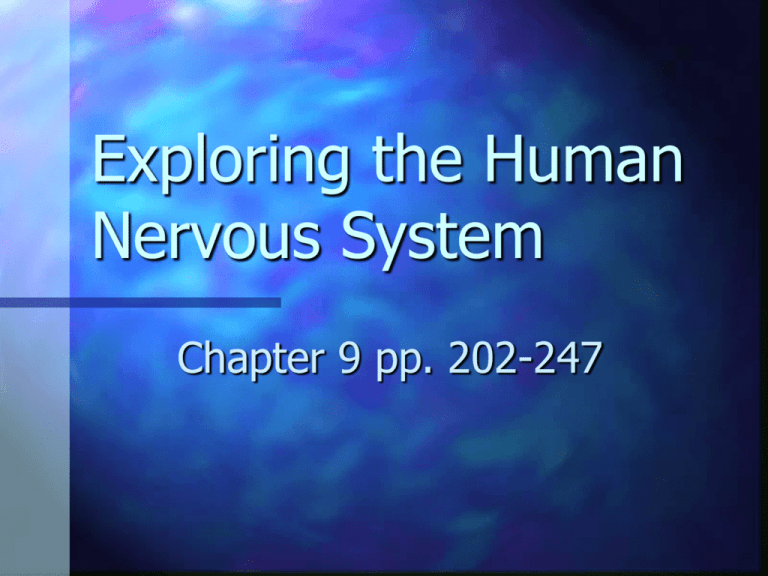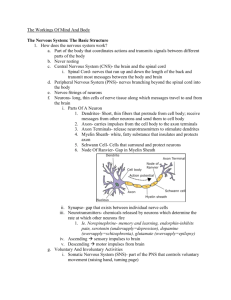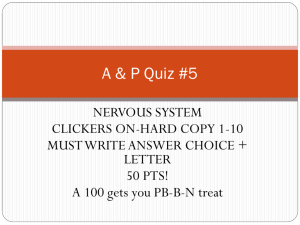Exploring the Human Nervous System
advertisement

Exploring the Human Nervous System Chapter 9 pp. 202-247 Introduction to the Nervous System What is the nervous system? It is a communication system that gathers information, interprets that information, and makes either conscious or subconscious reactions. The fundamental unit of the nervous system is the neuron (nerve cell) Vocabulary: due Wednesday Peripheral nervous system (PNS) Central nervous system (CNS) Nerve impulse Dendrite Axon Nerve Sensory receptor Somatic nervous system Autonomic nervous system Myelin Sensory neurons Interneurons Brain stem Cerebellum Sulcus Motor neurons Nerve pathways p.218 Synapse Neurotransmitter Excitatory response p. 214 Inhibitory response p.214 Reflex arc Reflex Meninges (meninx) White matter Grey matter Spinal nerves Cerebrum Diencephalon fissures convolutions The Fundamentals of the Nervous System Composed of 2 types of cells Neurons: nerve cell that transmits impulses Neuroglia: helper cells that aid and protect the parts of the nervous system What are nerves? – Bundles of nerve fibers Divided into 2 main branches Central Nervous System (CNS) Brain and spinal cord Peripheral Nervous System (PNS) Consists of perpheral nerves that connect the CNS to the rest of the body The nervous system provides sensory, integrative, and motor functions to the body. Motor functions can be divided into the consciously controlled “somatic nervous system” and the unconscious “autonomic system”. Neuroglial cells Function to fill spaces, support neurons, provide framework, produce myelin, and carry on phagocytosis. The only neuroglial cell we will look at is the Schwann cell. Myelin producing neuroglial cell located in the PNS. Myelin is a fatty covering that protects and insulates an axon. It helps impulses transmit easier. Neuron Structure Cell body containing a nucleus Nerve fiber contains a single axon and many dendrites. Dendrites carry impulses from other neurons to the cell body. Axons carry impulses from the cell body to dendrites of neighboring neurons. Functional Classification of Neurons Sensory Interneurons gather data; detect changes in environment Located in the PNS located in CNS Link other neurons Motor carry impulses from the CNS to effectors (muscles or organs responding to change). Located in the PNS Nerve Impulse Conduction Unmyelinated fibers conduct impulses over their entire membrane surface. Myelinated fibers conduct impulses from node of Ranvier to node of Ranvier, process called saltatory conduction. Saltatory conduction is faster than conduction on unmyelinated neurons. Follows the “All-or-None Response” Junction between 2 neurons is called a synapse. How do impulses get across the synapse? Neurotransmitters or chemical messengers, are released into the synaptic cleft. If the neurotransmitter allows for an increase in sodium ion permeability, then an impulse is triggered. If the neurotransmitter decreases the flow of sodium ions through the path, then the impulse is stopped. There are at least 50 kinds of neurotransmitters within the nervous system. Reflexes An automatic, unconscious response to a stimulus Stretch reflexes: Occur when a muscle is stretched by a tap over its tendon. Stretch receptors called muscle spindles, initiating an impulse over a reflex arc. Reflexes Reflexes: “ Special” Responses Produce rapid, involuntary movement or response Important in times of danger Example: Blinking eyelids when insect approaches eye or when startled by unexpected loud noise Why are reflexes so fast? Involve few neurons Many reflexes never reach the brain; travel only as far as the spinal cord Example: Blinking eyelid occurs before cerebrum is even aware of danger Reflex Arc Simplest type of nerve pathway What happens in a reflex arc? Sensory receptor at the dendrite end of sensory neuron detect a change Sensory neuron communicates with interneurons in CNS Interneurons communicate with motor neurons, whose axons lead out to effector muscles or glands. Examples of Reflexes Knee-jerk reflex Ankle-jerk reflex Response: knee extension Effector muscle: quadriceps Response: Effector muscle: Biceps-jerk reflex Response: Effector muscle Triceps-jerk Response: Effector muscle Plantar reflex Response: Effector muscle: Babinski: Meninges Layered membranes that lie between bony coverings and the soft tissues of the CNS Act to protect the brain and spinal cord. Three layers: Dura mater: outermost layer; tough, white, fibrous connective tissue; many blood vessels and nerves Arachnoid mater: middle layer; weblike; no blood vessels Subarachnoid space: contains watery cerebrospinal fluid Pia mater: inner most; contains many nerves and blood vessels that nourish the cells of the brain and spinal cord. The CNS: Spinal Cord The slender nerve column that passes downward from the brain through the vertebral column. Consists of 31 segments, each giving rise to a pair of spinal nerves. Spinal nerves are accessory organs to the PNS. Two major functions Conducting nerve impulses Center for spinal reflexes. Knee-jerk reflex Withdrawal reflexes Spinal cord innervations Cervical vertebrae (1-7) located in the neck Thoracic vertebrae (1-12) in the upper back (attached to the ribcage) Lumbar vertebrae (1-5) in the lower back Sacral vertebrae (1-5) in the hip area Coccygeal vertebrae (1-4 fused) in the tailbone The CNS: Brain Anatomy Four regions of the brain: Cerebrum: Cerebellum: Sits below and behind the cerebrum Coordination and balance Brain Stem: Largest region Nerve centers associated with sensory and motor functions/ provides higher mental functions Involuntary life processes (ie. Breathing and heart rate) Diencephalon: Processes sensory information The Cerebral Cortex Structure of the cerebrum Divided into two cerebral hemispheres connected internally by the corpus callosum. Surfaces ridges are called convolutions. A shallow groove is a sulcus; a deep groove is a fissure. Cerebral cortex: thin layer of gray matter which is the outermost portion of the cerebrum. Contains 75% of all neuron cell bodies 4 lobes Frontal: reasoning; planning, parts of speech and movement, emotions, and problem solving Parietal: perception of stimuli related to touch, pressure, temperature and pain Temporal: perception and recognition of sound and memory Occiptal: vision Answer the following! If Christopher is in a car accident and due to brain damage loses his sight, which lobes of the brain were probably damaged? When you go to the refrigerator and reach for a can of pickles, which lobe of the brain are you using? When you are listening to music on earphones, which lobe of the brain are you using? When an Olympic gymnast does a flip on the balance beam, which lobe(s) of the brain is she using? Diencephalon and Brain Stem Diencephalon Located between cerebral hemispheres, below the corpus callosum. Includes the thalamus, hypothalamus, optic chiasma, pituitary gland, mammillary bodies, and pineal gland Brain Stem Located from the diencephalon to the spinal cord. Includes the: Midbrain Pons Medulla oblongata Cerebellum Reflex center for processing information concerning body position Injuries to this area could lead to: Tremors Inaccurate movements of voluntary muscles Loss of muscle tone An awkward walk Loss of equilibrium The PNS Somatic nervous system Cranial and spinal nerves that connect to skin and skeletal muscles Conscious activities Autonomic nervous system Connects CNS to the lining of hollow organs and glands Controls unconscious activities Cranial and Spinal nerves








